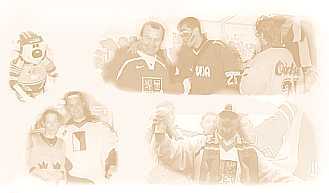Ice hockey without ice is in-line hockey. The same size rink, the same
size posts, the same number of outfield players as in overtime in NHL
regular season :-). There are different rules for off-side and the play is
not so agressive. The rules do not encourage body play. The game is
divided in four quarters resembling NBA.
The popularity of in-line hockey is growing all around the world. It is
believed that it will be played at the Olympics soon. In-line hockey
began in North America. In U.S.A. two professional leagues were
founded. Many ice hockey players filled their summer break with playing
these competitions, e.g. Canadian Mark Messier and Swede Mikael
Nylander. Also in Europe there were attempts to found a professional
league. Few years ago such a league was played in Switzerland but lasted
for just one season, this year there is one in Germany. At the World Cup
the German in-line hockey team was joined by an ice hockey star Jan Benda
who played SM-liiga in Finland last season. Germany really took this
tournament seriously, even choosing five in-line hockey players for the
national team of Russian origin. Another strong nation in in-line hockey
besides Finland, Sweden and Slovakia is the Czech Republic. However, there
is a big disorder in in-line hockey federation in the Czech
Republic. Actually there are two federations. One of them chose the
national team for the World Championship in Amiens and the other picked up
players for the World Cup. Both teams included some experienced ice hockey
players from Czech Extraliga. In-line hockey is very popular in Spain and
Latin America where there are no proper wheather conditions for ice
hockey. However, ice hockey nations are still dominating an in-line
world. The 1st annual World Cup proved that.
A week after the in-line hockey World Championship finals in Amiens, France, 12 nations met in the Eastern Bohemian cities - Chocen and Hradec
Kralove. The audience in a small stadium in Chocen was rather quiet. If
the Czech national team had not participated in the game only about 50
spectators would have been present. Only did, most of the time not routing
for anyone. When the Czechs were on, about 800 people made a better
atmosphere. In Hradec Kralove there was more noise. Hradec Kralove has
about 100 000 people and has a much larger stadium. About 4000 people
watched the finals there.
There were big differences among the teams. The teams from South America and Australia were weaker than the rest. Only Hungary could compete with
them. However, even Brazil took a lead over the Czech Republic 1-0, and
even though it eventually lost 2-17, the Czechs were desperate at the
beginning. Mainly Australia, Brazil and New Zealand showed really good
spirit and were improving with every game. The completely disasterous
tournament was the World Cup for the Chilians. They lost all their games
and while transporting to the Czech capital of Prague they had a terrible
accident where the person in charge died and nine people got injured. Two
of them (one of them was a Brazilian) had to be transported to the
hospital by a helicopter.
The great game to remember was a game between the Czechs and the
Swedes. The Czech Republic needed the victory to have a real chance for
gaining a medal but the Swedes showed up strong and got the early 5-2
lead. But the Czechs came back and they won 7-6 in an amazing
atmosphere. The Czechs managed it to the semifinals with the help of
others and after their victory over Germany, landed in the finals against
the Finnish team which had beaten the U.S.A.. The Czech fans created a
great atmosphere for the finals but it did not help the Czech
team. Finnland gave no chance to the Czech Republic and won the title. In
the bronze medal game the U.S. team beat the Germans.
The final standings:
1. Finland
Karhu, Ekman - Tuominen, Puolannen, Unkuri, Peltonen, Makinen, Takala,
Myllymaa, Lisko - Halonen, Kuhta (C), Koskinen, Jarvenpaa, Kivenmaki,
Haatila, Korhonen, Kalliomaki
2. Czech Republic
Altrichter, Portlik - Blaha, Beranek, Vozdecky, Vesely, Broz (C), Seda,
Eiselt, Jindrak, Bauer, Pisa, Schubert, Vich, Vrba, Jost, Mikel, Kos
3. U.S.A.
Bonvie, Hoffmann - Menicci, Melson, Laylin (C), Larsson, Drevitch,
Milewski - Skoryna, Rice, Wilson, Watanabe, Lund, David, Hanson
4. Germany
5. Slovakia
6. Sweden
7. Austria
8. Netherlands
9. Australia
10. Brazil
11. Hungary
12. New Zealand
13. Argentina
14. Chile
The best goalkeeper of the tournament: Martin Altrichter (Czech Republic)
The best defenseman of the tournament: Tye Melson (USA)
The best attacker of the tournament: Kimmo Kuhta (Finland)
The Good Sportsmanship Award: New Zealand
ada, Hadak
HockeySport.net - the leading European In-Line Hockey news site.


